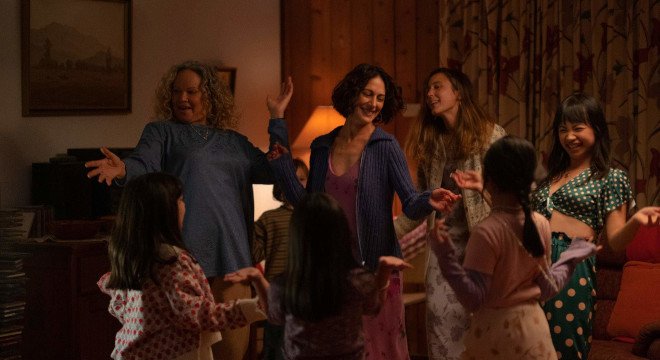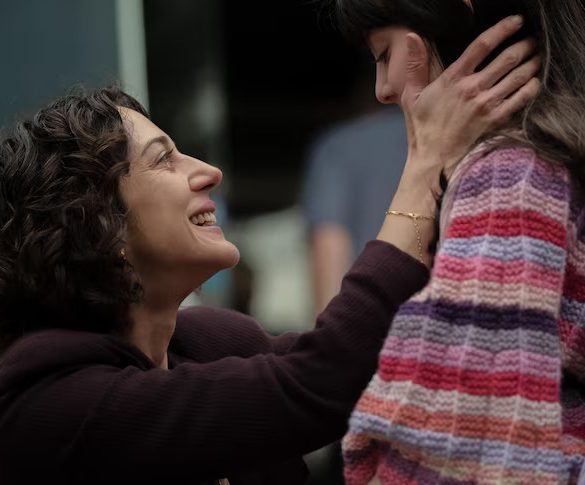In the below discussion, Sherwin talks about his working relationship with Noora, the inspiration that comes from Iranian Cinema, as well as how he managed to delicately capture the energy of the moments of joy that amplify the humanity within Shayda.
Shayda is currently in Australian cinemas and is also Australia’s submission for the Best International Feature Film at the upcoming Academy Awards.
This interview has been edited and condensed for clarity.
Congratulations on Shayda and The Giants. They’re both phenomenal films. What does it feel like to have two very different films released this year?
Sherwin Akbarzadeh: Often it takes so long to get a film finished that I feel firstly fortunate to have them both out. There’s also a TV show coming out later this year as well, Swift Street, so this is like the cherry on the cake at the end where you get to actually show your work and people get to see them and provide feedback and bring their own perspectives to it. It’s pretty short lived compared to the long arduous process of actually making the thing, so it’s great to just soak it up and have it on happening on multiple fronts.
You worked with Noora on some of her short films – Waterfall (2017), Tâm (2020). Can you talk about the relationship that you’ve built over time as a cinematographer and director team?
SA: We knew how to work with each other from those shorts. Every collaboration I have with a director is different and it’s led by the type of director they are and what their process is. With Noora, she’s very planning focused. We planned and shot listed everything. We talked extensively through all the moments in the film. I became involved early on and I had read early drafts of the scripts. Even before she finished her last draft, I was involved in shot listing with her and making sure that there was a clear sense of perspective in all of the scenes. It was important to us that the film is intimate with Shayda, and also Mona sometimes, but mainly Shayda and that the film is told through her eyes.
I imagine that when you’re shooting with Selina that having a complete shot list would help with the limitations of shooting with young actors. Is that right?
SA: Yes and no. We planned those scenes very much because we knew we would not have as much time with Selina because A) she is a child, so there’s a limited amount of takes that she’s able to do, and B), the number of hours that we had access to her due to child labour restrictions, meant the schedule was much tighter during her time on set, so we did plan very meticulously. Also, because of the speed that we had to work, it was almost like shooting a documentary. We filmed fairly long, almost unstructured takes where we would have scripted moments, but we’d also let them play. I think the chemistry that you get on in the film between mother and daughter is thanks to the documentary approach that we brought to Selina’s scenes.
That makes sense. It is a powerfully intimate film as we’re brought into the beauty and the warmth of the world that Shayda has with Mona, then there is also that tension and the anxiety of the thriller aspects of the story with the husband, Hossein. Yet, we don’t ever lose the aspect of intimacy. Can you talk about balancing that warmth alongside the anxiety in that close quarters style?
SA: I think the one of the aims was to capture that duality between reflecting Shayda’s trauma and fear and anxiety and the darkness with all of the hope and the joy and the light of the mother and daughter connection and the celebration of Persian culture, and the connection between the women in the shelter as well, to some extent. My approach to lensing and to lighting was quite different in those scenes. The dark scenes are dark and the bright scenes are relatively bright. I really wanted to feel that tension between hope and fear. I feel if you only had one of them, you wouldn’t feel them in the same way. They make sense in contrast to one another.
As we’re talking about the emotions of the film, I’m curious how you managed to capture the joyful energy of the dancing scenes or the Chaharshanbe Soori festival scenes with the fire-jumping. For some films, that kind of joyful energy doesn’t translate comfortably on screen, but it appears here naturally.
SA: For all the dancing scenes, there was a lot more dancing that happened than what actually made it into the cut. I think that’s actually the key, it became real so it was like shooting a documentary. We created an environment for the actors to just really have fun. I had a handheld camera to follow actors, which meant not restricting actors with where they had to stand or if they had to hit marks or not, they could really go anywhere they wanted to go. The lighting was accommodating of that as well. I think that contributes to the naturalism that you see on screen.

I’m curious then, if we can talk about The Giants for a moment and the difference in the documentary filmmaking there compared to the documentary style of shooting you implemented with Shayda. How do you differentiate between the two styles of film?
SA: In some ways, I feel like shooting Shayda may have been a more documentary, observational energy than shooting The Giants, which was actually quite constructed. Apart from the Bob Brown scenes, we shot listed all the things that we needed to get to shoot the scenes in nature. We planned the shots that involved a lot of infrastructure, like cable cams, special lenses, and gimbals. Technologically, there was a lot more infrastructure that was involved in The Giants, which locked us in to certain shots and certain ideas. It’s interesting that that’s the documentary and Shayda is the drama, because I feel like they’re almost reversed.
I’m curious then, do you find yourself drawn to a certain style or format of filmmaking as a cinematographer?
SA: No. I like being a chameleon. One of the joys of my job is that I can just adapt to my environment and find what’s right for the story and try and service that. With Shayda, it was actor driven; that was the key to the film, to allow them to do what they needed to do and to not bring attention to the cinematography, more so than some other films that I’ve done.
I was reading an interview that you did earlier in the year where you referred to Andrea Arnold who said that ‘the camera should never enter a room before a character.’ That feels like a very character driven thing to do, but I’m curious if you can talk about that a bit more in how you implemented that mindset into Shayda.
SA: The ethos of Shayda was subjectivity and intimacy. Having the camera be subjective to Shayda’s experience, and in some scenes Mona’s experience. The camera was pretty much glued to either of those two characters, either of them are in every scene so we can tell the story from their perspective, so if Shayda enters a room, I would be entering the room with her. I wouldn’t be planted already in the room and seeing her come in through the door.
That brings that intimacy into it again. On set, how does that feel when you’re so close to the actors and you’ve got your crew and the sound team behind you capturing everything else? How does that feel to be there in the moment?
SA: It’s amazing. One of the privileges of the job is that I get to be the first person to see their performance and to see the magic that’s going to get stitched together in the edit. I don’t know how the actors do it having the camera that close to them, it’s quite confronting. My hero lens on Shayda was a 40 mil, so I’d be quite close up to the actors. I would be about a foot away, or something like that from their face. Selina managed it without any problems. I somehow just disappeared into the set, and they were able to give these amazing performances.
I’m a big believer in the proximity of the camera to the actors in this type of film language. I think you can feel that proximity and the audience feel like you’re really there with them. In the back of our minds, we knew that if it wasn’t gonna work out or if those if I was too distracting, I would be able to step back and go on a longer lens.
What did you shoot on? I’m curious also about the conversations that you may have had with the colourist Edel Rafferty about creating a celluloid quality for the film out of digital?
SA: We shot on the Alexa Mini. We rated it at 1600 ISO which has a natural inherent noise structure to it, which looks a bit like film grain. I was conscious of trying to not emulate film exactly, but to bring a sense of celluloid to it. I think you fall into a trap of trying to make it look exactly like it was shot on film because it never quite will. I just wanted to embrace texture. I feel like there’s something in a textured image that makes us feel the emotion of the scene more vividly. It always felt right to have a little bit of texture in this film. We would have shot on film, and we had early conversations about it, but we never really entertained it knowing that we’d be shooting long takes with the child actor.
What is wonderful about Shayda is that it shows a cultural diaspora that we don’t see often in Australian film. I understand that’s something that Noora and yourself share. Can you talk about the importance of being able to show your culture on screen?
SA: My background is that until I was about nine, I was living back and forth between Australia and Iran. So as a teenager, I had this kind of connection and a yearning to go back to Iran. I was interested in filmmaking already from that age and I wanted to make a film in Iran. One of the reasons I’m a filmmaker is because of the Iranian New Wave films of the 90s, they really influenced me as a young person.
Being Iranian and being a filmmaker are closely connected for me, so it’s quite a homecoming to make this film. It’s connecting different parts of my personality and my psyche to be able to make this film. It’s a Farsi language film reflects and celebrates the culture of Iran. As a question of representation, I’m really proud that we get to show that on screen. It doesn’t happen often enough where you get to see non-white stories up on the screen in Australia, so I’m really proud to be part of that and to help motivate more stories like this coming out.
As you mentioned Iranian cinema, there is a touch of the masters of Iranian cinema. There are hints of Abbas Kiarostami here with the presentation of kids on screen. I’m curious if you referred to any of the Iranian films or filmmakers leading up to shooting Shayda?
SA: We talked a bit about Asghar Farhadi’s A Separation and that was more to do with the Shayda character. The poetry of the Iranian New Wave is something that has always been part of me and Noora’s conversation and collaboration, and it was something to strive towards, to find those poetic moments. I don’t know in what way it made its way into Shayda, but I think, certainly on Noora’s part of in the script writing process, having a child actor like that feels very much like a nod to the Iranian New Wave.




